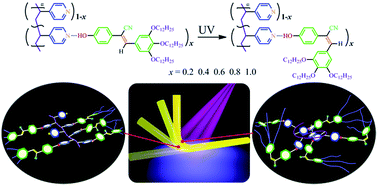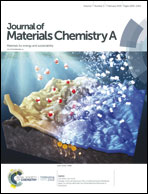Fast photoinduced deformation of hydrogen-bonded supramolecular polymers containing α-cyanostilbene derivative†
Abstract
Photodeformable polymers have gained significant advancements in the past decade for their significant value in the design of light-driven soft actuators. Most of these polymers are constructed using the azobenzene chromophore. It is of great interest to seek out new chromophores other than azobenzene for fabricating photodeformable polymeric materials. Here, we report a series of hydrogen-bonded supramolecular polymers P4VP(Z-TCS)x composed of poly(4-vinyl pyridine) (P4VP) as main chain and an α-cyanostilbene derivative (Z-TCS) as side groups. The polymers show excellent photoinduced deformation ability under UV irradiation, in terms of both bending speed and bending angle. In addition, the shape of these fibers formed by UV irradiation can be eliminated via external stretching force and recovered under heating due to the uneven distribution of Z and E-cyanostilbene isomers along the radial direction of the fibers. Therefore, the P4VP(Z-TCS)x fibers can be used in the information encryption realm and other intelligent manufacturing materials. To the best of our knowledge, this is the first report of photoinduced deformation displayed by an α-cyanostilbene-based polymer, which broadens the potential applications of the α-cyanostilbene derivative as a photodeformable material.



 Please wait while we load your content...
Please wait while we load your content...